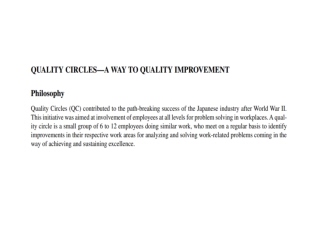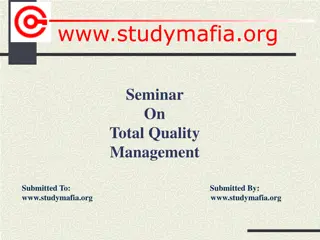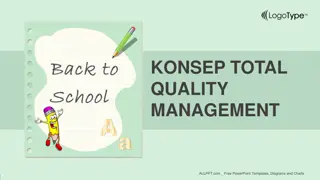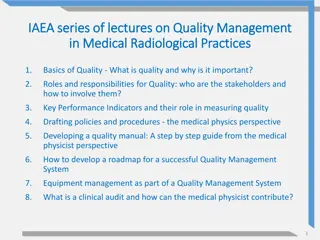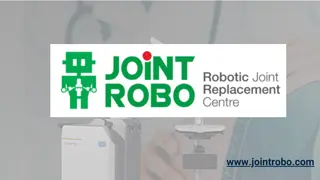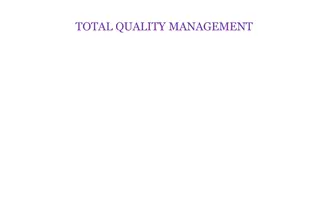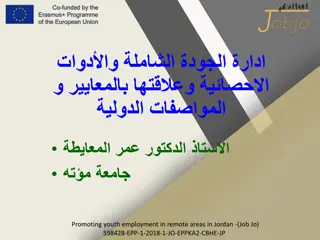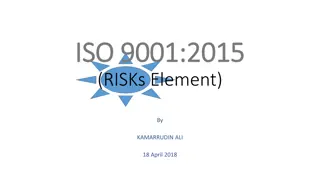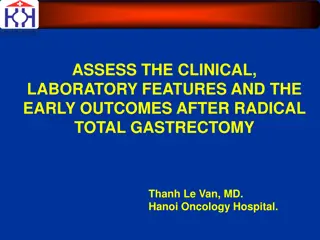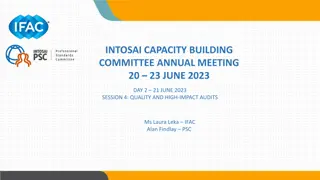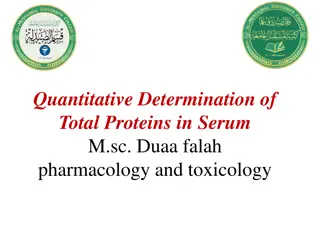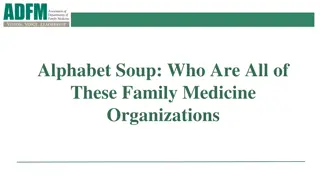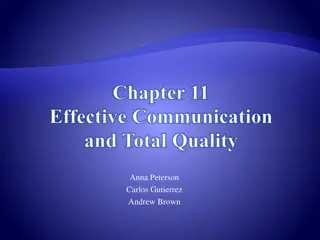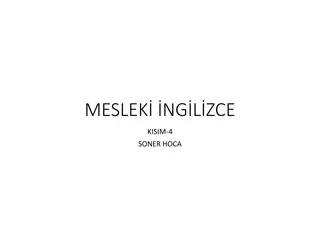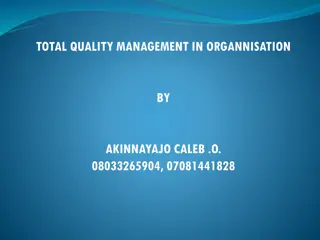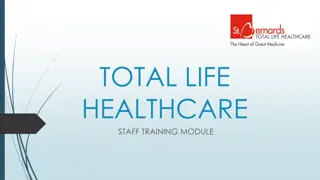Total Quality Management (TQM) in Organizations: A Comprehensive Overview
Total Quality Management (TQM) is a system approach that enhances quality and productivity in organizations through methods like CQI, SQC, QFD, QIDW, and TQC. TQM emphasizes quality, teamwork, and proactive management philosophies, aiming to continually improve products and services. Key elements include policy, product design, quality control, corrective action, and employee training. Deming stressed the importance of quality over quantity and the use of statistical process control for achieving organizational objectives.
Download Presentation

Please find below an Image/Link to download the presentation.
The content on the website is provided AS IS for your information and personal use only. It may not be sold, licensed, or shared on other websites without obtaining consent from the author.If you encounter any issues during the download, it is possible that the publisher has removed the file from their server.
You are allowed to download the files provided on this website for personal or commercial use, subject to the condition that they are used lawfully. All files are the property of their respective owners.
The content on the website is provided AS IS for your information and personal use only. It may not be sold, licensed, or shared on other websites without obtaining consent from the author.
E N D
Presentation Transcript
BY BY AKINNAYAJO CALEB. O. 08033265704, 07081441828 E-mailnuquekonsult2010@gmail.com AKINNAYAJO CALEB. O. 08033265704, 07081441828
INTRODUCTION INTRODUCTION Total quality management (TQM) refers to management methods used to enhance quality and productivity in organizations, particularly businesses. TQM is a comprehensive system approach that works horizontally across an organization, involving all departments and employees and extending backward and forward to include both suppliers and clients/customers. TQM is only one of many acronyms used to label management systems that focus on quality. Other acronyms that have been used to describe similar quality management improvement), SQC (statistical quality control), QFD (quality function deployment), QIDW (quality in daily work), and TQC (total quality control). Despite the ambiguity of the popularized term "TQM," that acronym is less important than the substance of the management ideology that underlies it. TQM provides a framework for implementing effective quality and productivity initiatives that can increase the profitability and competitiveness of organizations. philosophies and programs include CQI (continuous quality
Specifics related to the framework and implementation of TQM vary between different management professionals and TQM program facilitators, and the passage of time has inevitably brought changes in TQM emphases and language. But all TQM philosophies share common threads that emphasize quality, teamwork, and proactive philosophies of management and process improvement. As Howard Weiss and Mark Gershon observed in Production and Operations Management, "the terms quality management, quality control, and quality assurance often are used interchangeably. Regardless of the term used within any business, this function is directly responsible for the continual evaluation of the effectiveness of the total quality system." The authors went on to delineate the basic elements of total quality management as expounded by the American Society for Quality Control: (1) policy, planning, and administration; (2) product design and design change control; (3) control of purchased material; (4) production quality control; (5) user contact and field performance; (6) corrective action; and (7) employee selection, training, and motivation.
For his part, Deming pointed to all of these factors as cornerstones of his total quality philosophies in his book Out of the Crisis. He contended that companies needed to create an overarching business environment that emphasized improvement of products and services over short-term financial goals. He argued that if such a philosophy was adhered to, various aspects of business ranging from training to system improvement to manager-worker relationships would become far more healthy and, ultimately, profitable. But while Deming was contemptuous of companies that based their business decisions on statistics that emphasized quantity over quality, he firmly believed that a well-conceived system of statistical process control could be an invaluable TQM tool. Only through the use of statistics, Deming argued, can managers know exactly what their problems are, learn how to fix them, and gauge the company's progress in achieving quality and organizational objectives.
Joseph characteristics necessary for TQM to succeed within an organization: participative management; continuous process improvement; and the utilization of teams. Participative management refers to the intimate involvement of all members of a company in the management process, thus deemphasizing traditional top-down management methods. In other words, managers set policies and make key decisions only with the input and guidance of the subordinates who will have to implement and adhere to the directives. This technique improves upper management's grasp of operations and, more importantly, is an important motivator for workers who begin to feel as if they have control and ownership of the process in which they participate. Jablonski, author of Implementing TQM, identified three
Continuous process improvement, the second characteristic, entails the recognition of small, incremental gains toward the goal of total quality. Large gains are accomplished by small, sustainable improvements over a long term. This concept necessitates a long-term approach by managers and the willingness to invest in the present for benefits that manifest themselves in the future. A corollary of continuous improvement is that workers and management develop an appreciation for, and confidence in, TQM over time. Teamwork, the third necessary ingredient for the success of TQM, involves the organization of cross-functional teams within the company. This multidisciplinary team approach helps workers to share knowledge, identify understanding of their role in the overall process, and align their work goals with those of the organization. problems and opportunities, derive a comprehensive
Customer focus (includes internal customers such as other departments and coworkers, as well as external customers) Process focus Prevention versus inspection (development of a process that incorporates quality during production, rather than a process that attempts to achieve quality through inspection after resources have already been consumed to produce the good or service) Employee empowerment and compensation Fact-based decision making Receptiveness to feedback
In addition to identifying three characteristics that need to be present in an organization and six attributes of successful TQM programs, Jablonski offers a five-phase guideline for implementing total quality management: preparation, planning, assessment, implementation, and diversification. Each phase is designed to be executed as part of a long-term goal of continually increasing quality and productivity. Jablonski's approach is one of many that has been applied to achieve TQM, but contains the key elements commonly associated with other popular total quality systems.
PREPARATION. PREPARATION. During preparation, management decides whether or not to pursue a TQM program. They undergo initial training, identify needs for outside consultants, develop a specific vision and goals, resources, organization. draft a corporate communicate policy, commit goals the throughout necessary and the the
PLANNING. PLANNING. In the planning stage, a detailed plan of implementation is drafted (including budget and schedule), the infrastructure that will support the program is established, and the resources necessary to begin the plan are earmarked and secured. ASSESSMENT. This stage emphasizes a thorough self-assessment with input from customers/clients of the qualities and characteristics of individuals in the company, as well as the company as a whole. ASSESSMENT.
IMPLEMENTATION. IMPLEMENTATION. At this point, the organization can already begin to determine its return on its investment in TQM. It is during this phase that support personnel are chosen and trained, and managers and the workforce are trained. Training entails raising workers' awareness of exactly what TQM involves and how it can help them and the company. It also explains each worker's role in the program and explains what is expected of all the workers.
DIVERSIFICATION. DIVERSIFICATION. In this stage, managers utilize their TQM experiences and organization companies that have an impact on the business's overall health) into the quality process. Diversification activities include training, rewarding, supporting, and partnering with groups that are embraced by the organization's TQM initiatives successes to bring groups distributors, outside and the (suppliers, other
A ten step for continual improvement Determine current performance Establish a need to improve Obtain commitment and define the improvement objective Organize the diagnostic resources Carryout research and analysis to discover the cause of current performance Define and test solutions that will accomplish the improvement objective Produce improvement plans which specify how and by whom the changes will be implemented Identify and overcome any resistance to the change Implement the change Put in place controls to hold new levels of performance and repeat step one


